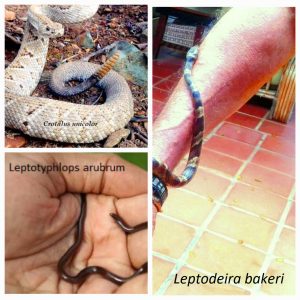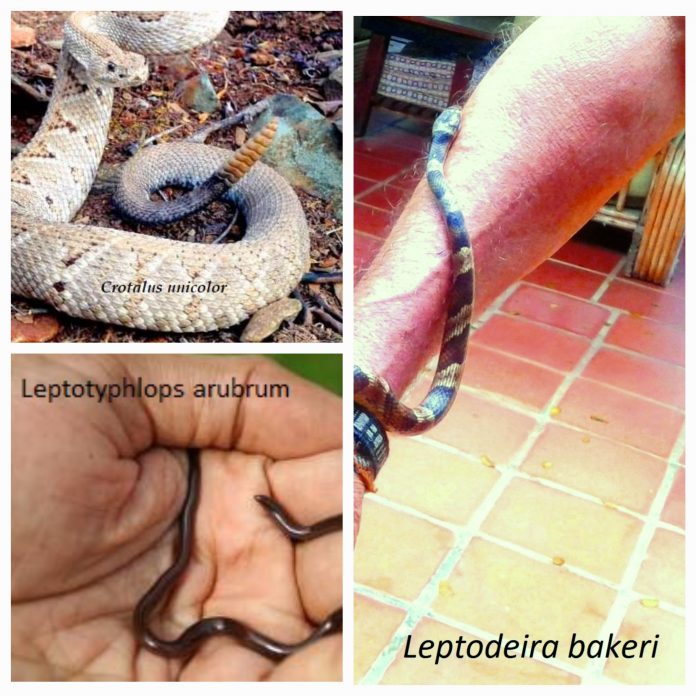Booking a magical glimpse inside Etnia Nativa
Article by Etnia Nativa call us 592 2702 and book your experience!
Each week, Island Insight shares with you a story of Aruba through the eyes of Etnia Nativa, where we welcome our guests to an island experience far beyond their usual expectations. We link you with the mystical aspects of the island, its native culture, and its traditional heritage. In this episode, we share about some species of snakes that evolved into separate or Aruban subspecies, island animals that are not found anywhere else in the world. However, they are all related to their continental ancestors. Thousands of years of isolation on our island have allowed them to develop and adapt their unique survival characteristics in behavior, size, and appearance. These are : “rattlesnake,” “santanero,” and “red worm or midget snake.”

Rattlesnake (Crotalus unicolor) is the native totem of agriculture, the caretaker of the harvest land, “Cuidado di Cunuco,” known locally as rattlesnake. This snake is relatively small—70 cm long. It is a venomous snake; it adapts to its environment, and its body is shades of gray, light brown or light pink. It has faint brown diamond-shaped markings on its back. The shapes and coloration of the diamonds are most visible on the backs of juvenile specimens. The rattlesnake’s most distinctive feature is the rattle at the end of its tail, which emits a buzzing sound when the snake becomes alarmed or threatened. These snakes are shy and not very aggressive; however, their venom can be dangerous and cause serious injuries.
They are snakes that sit and wait for their prey. You can usually find them waiting for prey under bushes, fruit trees, and shady places, waiting for lizards, mice, rats, birds, bat frogs, and even juvenile rabbits. They once lived all over the island, but are now restricted to the mountainous areas surrounding Arikok National Park. If you see one, don’t disturb it. Do not try to catch it; much less harm it, as it is an endangered and protected species.
Santanero (Leptodeira bakeri), or Aruba cat’s eye snake, also known as a stinking snake because of the foul smell that sticks to your hand when handled by a Santanero, or dweller of the graveyard, can be found all over Aruba. In times of rain, it is common to find them near dams and even crossing roads at night. Santanero is a slender snake and is approximately 50 cm long.
We can recognize this snake by the large scales on the top of its head and by its dark brown bands alternating with light brown bands. The belly is white or cream in color and is smooth, without any markings. They usually remain hidden during the day among plant leaves or under rocks. They are quite active at night when they are looking for their prey. They eat small toads, frogs, insects, and lizards. They often climb trees and cacti.
Santanero is shy and not aggressive at all when handled. However, it has enlarged teeth at the back of its upper jaws that emit mild venom that paralyzes its prey to be swallowed whole since Santanero does not coil around or constrict its prey to suffocate and immobilize them. Although mildly venomous, Santanero rarely bites when handled, and its venom is not considered dangerous to humans. Even though the old ways warn that its bite could make you suffer a dull, persistent pain and aching of your bones for some days, especially the long bones of your arms and legs.
Small red worm snake (Leptotyphlops arubrum), to which we have dedicated the episode “Get to Know Aruba’s Small Snake, lives mainly underground, is very cryptic, and hunts termites and ant eggs. Not much is known about their habits. We know these snakes can reproduce different pheromones, allowing them to enter termite nests, etc. The insects do not recognize the intruder due to the pheromone it imitates, and therefore the termites or ants do not sound the alarm to defend themselves or attack. These snakes also have the ability to leave trails for termites, which lead them to their nests.
If knowing more about Aruba is on your itinerary, Etnia Nativa is your only choice—a unique native gem! Let Anthony, our acclaimed cultural columnist, guide and lecture you regarding the most interesting and revealing stories regarding Aruba’s uncovering knowledge acquired through generations of native ethnic presence, an beyond beaches learning adventure. Visit his magnificent dwelling that integrates reused materials with nature, bursting with culture and island heritage! Whats App +297 592 2702 etnianativa03@gmail.com




















